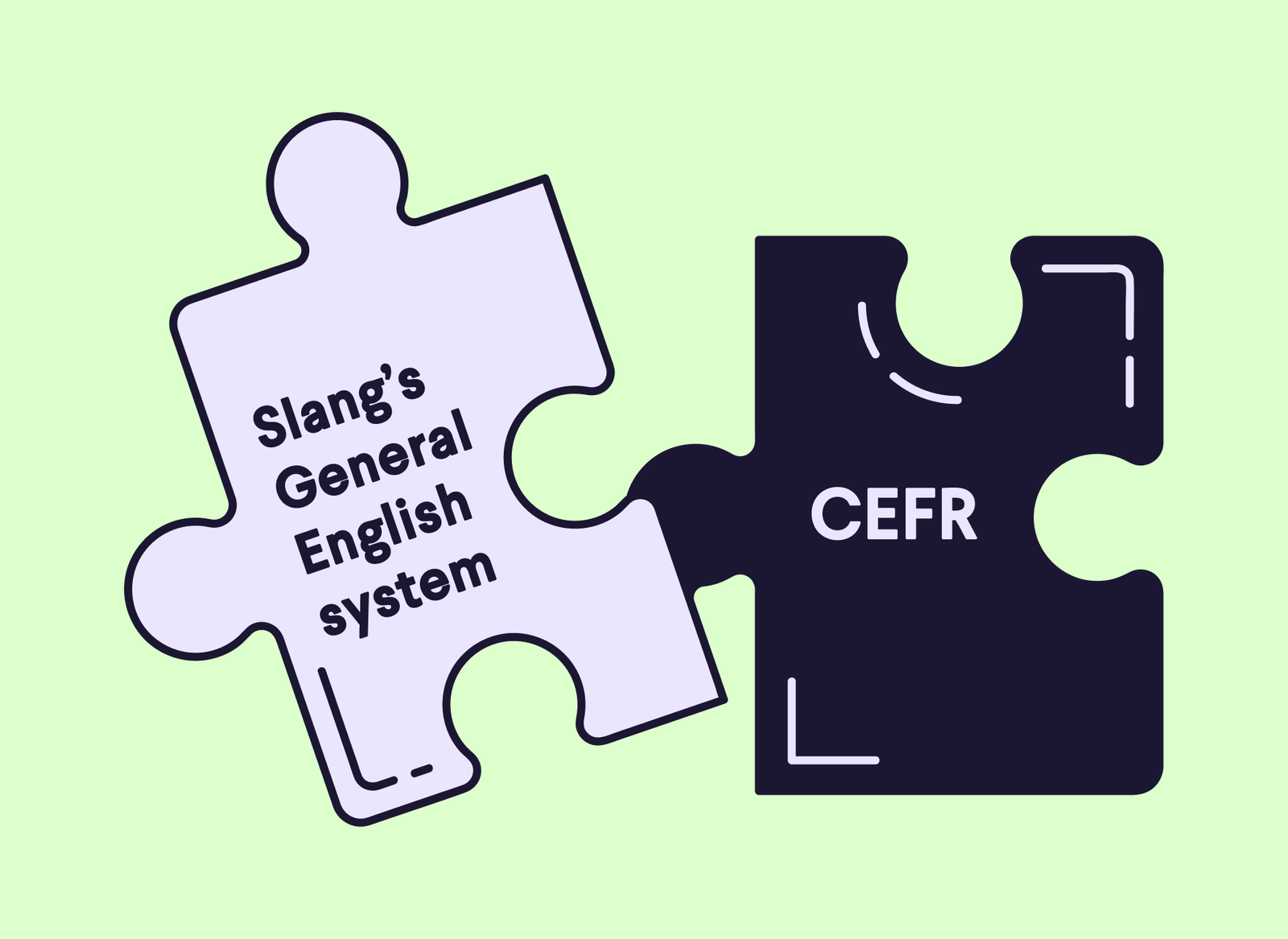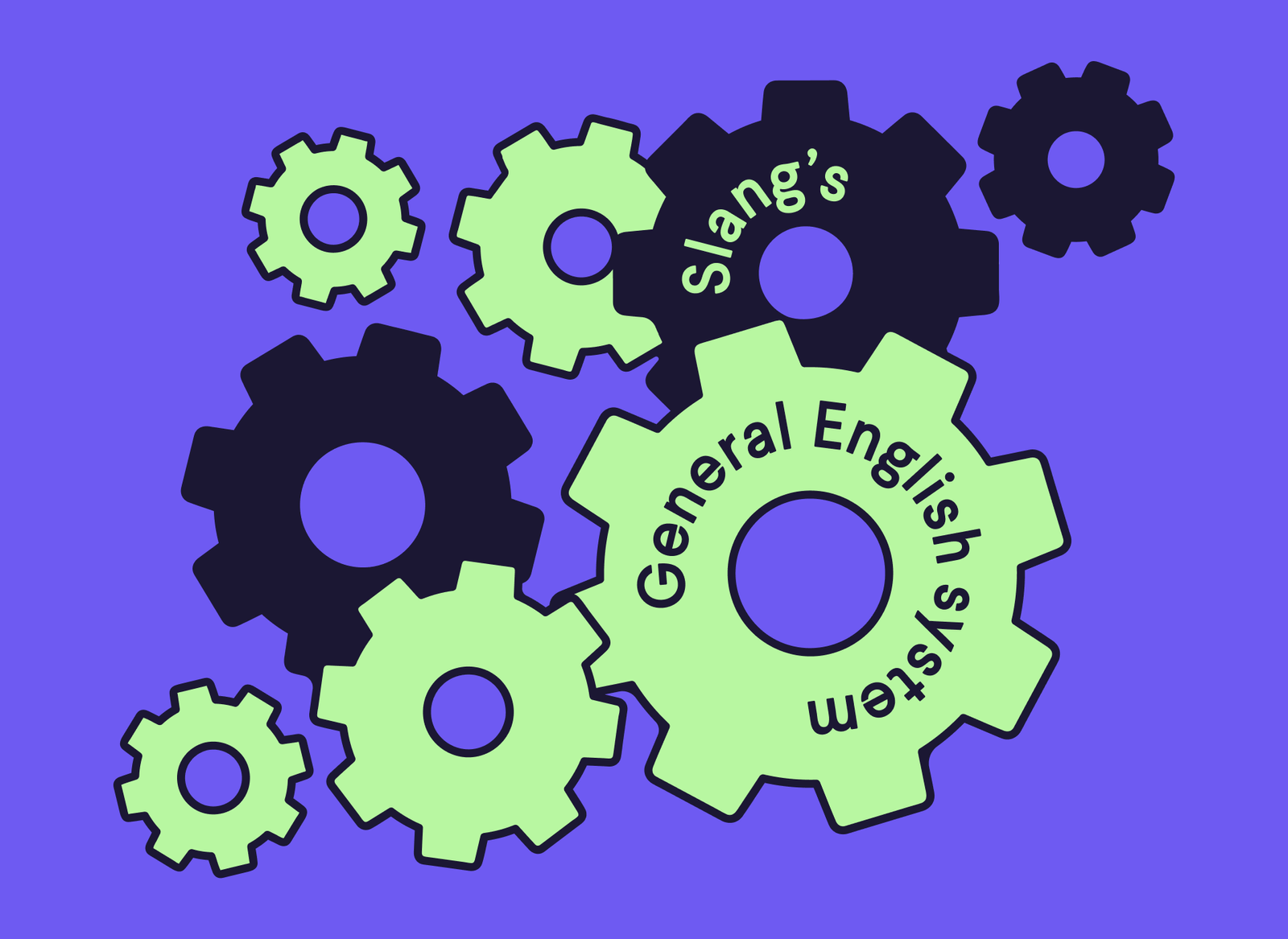You’ll also need strong communication skills to navigate situations like making small talk with colleagues or taking a business trip.
At the same time, however, many general English programs on the market today are too general, covering a wide range of topics that will not be relevant to everyone. If you’ve ever opened an English textbook to the chapter on zoo animals and wondered, “But how will this help me interact with my clients?”, you know what we’re talking about!
Slang’s General English system is designed to bridge this gap by helping you improve your overall English fluency in contexts that are relevant for professionals. Each of our levels centers around useful topics from daily life, with a focus on things that are likely to come up in the workplace. Examples of these topics include things like making small talk or giving a presentation.
With this thematic focus, it’s easy to take what you’re learning and apply it right away as soon as you’re in that situation!
After all, Application of language skills in real-world settings is essential to cement what you’re learning. What’s more, you can also study our General English courses in conjunction with any of our specialized English courses, allowing you to progress in these broader communicative skills and technical English at the same time!
Image: Some of Slang’s General English course levels
Slang’s dynamic curricula are optimized for each user in real time based on individual needs and linguistic data from our lexicon. As a result, users study only what they don’t know or need to reinforce, and can thus reach their learning goals faster. And unlike traditional textbooks, if you’ve already seen something in one course, we’ll never waste your time by teaching it to you again!
Do you really need to study the word “manager” in the context of Performance Management, and then again in the context of Recruiting, and then again in the context of Business Communications? No, we don’t think so, either!
With Slang, user knowledge and progress is centralized and synced across all our courses. This means users can transition seamlessly between our general English and professional English offerings at any time, depending on their career needs, without any backtracking.
Another complaint we’ve heard from our learners about traditional General English curricula, for example in school, is that they get assigned to a level with other students who have very different English skills. This causes them to spend a lot of time reviewing things that they know but other students don’t know from that level.
Slang solves this problem with dynamic curriculum optimization algorithms. Our technology selects appropriate content for each user based on their prior knowledge of English and their development in the four communicative skills (reading, writing, listening, speaking).
This personalized approach recognizes that learners, even at the same level, differ widely in English background and proficiency and that individual learners often have varying ability levels across the four skills.
Thus, a diverse group of students may all reach the same level goal, but with different learning pathways uniquely optimized for their needs. Isn’t that what busy professionals need – an efficient and personalized way to level up their English without wasting time on things they already know?
Slang’s General English Level System
Our General English system focuses on teaching common words and expressions that are necessary for the everyday life of professionals. The activities in which this content appears are designed to build the four language skills: reading, writing, listening, and speaking. Within each level, students will study a small cluster of different topics.
These topics were selected according to the approach described previously to provide a balance of structure and variety within each level. The table below summarizes what learners will master as they move up within our framework. A complete list of topics covered at each level can be found on our website.
The levels are designed to build on each other, so that learners will encounter more advanced content about the same topic in a later level. For example, learners in our very first level, Beginner 1, will learn to identify common food and drinks eaten at different meals. Later on level Elementary 1, they will be able to use this knowledge in a communicative context by making a restaurant reservation.
They will continue to build on this knowledge in level Elementary 3 by practicing how to order specific dishes and handle problems with their food order with waitstaff. This approach not only enables users to continually build on their communicative skills in progressively more complex situations but also motivates them to continue improving as they see how their knowledge will serve them in real-world contexts!
Images: Food-related chapters from Beginner 1 (top) and Elementary 3 (bottom)
We are sometimes asked why we don’t offer “Advanced” level courses in our General English system. This is because of our strong belief in personalized learning. Once users have reached the level of conversational fluency (in other words, once they have completed all of the General English levels), we believe they are much better served by taking professional courses that align with their unique career interests.
This will allow them to continue building their communication skills in the contexts where they most need them for work or school. Of course, because our professional courses adapt to your proficiency, you don’t necessarily need to wait to complete the entire General English system before starting to learn specialized English.
Unlike in traditional fixed curricula, with Slang, your knowledge is automatically transferred between all your courses, so the choice is yours where you’d like to focus your attention!
Each of Slang’s levels is designed to take approximately 30-50 hours to complete. The exact study time needed depends on a number of factors including student dedication and amount of prior progress in other courses within the Slang platform. Having levels of comparable size makes it easy to implement Slang at organizations with students from a variety of different proficiency levels, as is often the case with ESL schools or universities.
You can simply assign students to improve their ability by a specified number of levels within a specified time frame, depending on the intensity of the study program. For example, learners might be asked to complete one level per semester. Keep in mind that our academic consultants are experts on goal-setting and benchmarking with Slang’s General English levels, and we would be happy to assist you in designing a personalized program for your institution.
| Level | Description |
| Beginner 1 | Start paving your way to proficiency! Learn the days of the week, colors, hobbies, and other topics to kick-start your conversations in English. |
| Beginner 2 | Take the next step! Describe your house and its furniture, talk about places around town and how to get there, and start planning a trip abroad! |
| Elementary 1 | Ready to move up? From boarding a flight to establishing a routine to telling new friends about your family back home, learn the language required to survive in a different country. |
| Elementary 2 | Get comfortable using English in a variety of situations, from banking essentials like using an ATM and opening an account, to preparing for presentations at school or work! |
| Elementary 3 | Improve your cultural competence! Acquire the knowledge necessary to avoid misunderstandings in any setting, whether you’re out to eat or making plans with friends. |
| Intermediate 1 | Keep expanding your English proficiency in a variety of settings. Express your opinions about music, movies, and books, and gain the language skills to manage your personal finances. |
| Intermediate 2 | Nervous about using English at work? Build your confidence in professional settings as you learn expressions that will help you excel in interviews and on the job! |
| Intermediate 3 | Increase your fluency as you incorporate more idioms into your conversations, whether you’re narrating an anecdote or talking about the weather. |
| Advanced Intermediate 1 | Take your English and financial literacy to the next level as you manage your income, make smart investments, and stay up to date on economic news. |
| Advanced Intermediate 2 | You’re making excellent progress on the path to proficiency! Delve deeper into topics related to politics, ethics, work, and academics, and get ready to think and speak critically! |
Alignment with External Testing Systems
Many of our clients rely on Slang for learner benchmarking. Slang proficiency scores can be used for a variety of diverse purposes, ranging from hiring decisions for roles that require professional English to graduation requirements for university students.
As an international company, we recognize that there are a variety of different English proficiency systems used for testing, placement, and certification in the countries where our users live. A key goal in the development of our General English level system was to create a system that could be easily and accurately aligned with any such benchmarking system, rather than limiting ourselves to a single third-party framework.
Currently, the most popular alignment system used by our clients is the Common European Framework of Reference (CEFR). The CEFR framework is the standard language certification system used in the European Union as well as many other countries. This system spans six levels: A1 & A2 (beginner), B1 & B2 (intermediate), and C1 & C2 (advanced). It is based on “can-do statements” which define the real-world situations a user should be able to navigate at each level of linguistic proficiency.
There is no single, static definition of specific wordlists or grammar rules that a learner must memorize for a given level; instead, curriculum developers must select the content which they believe will best support the learner’s development in the four language skills in order to master the can-do statements. We believe that the CEFR system’s emphasis on communicative competencies aligns well with Slang’s personalized approach.
If your organization currently uses the CEFR system for course placement or proficiency measurement purposes, you can easily integrate Slang’s General English courses into your existing framework. The table below shows the approximate CEFR level a user will have achieved after completing each course within Slang’s General English system. These correspondences were based on extensive curriculum research into different implementations of the CEFR framework, with an emphasis on the topics needed by our core audiences of professional learners.

We’re always seeking to develop the best courses on the market, with the content you most want to see. If you’re interested in courses that are a bit more specialized and aligned with your career, check out our full course offering here.





